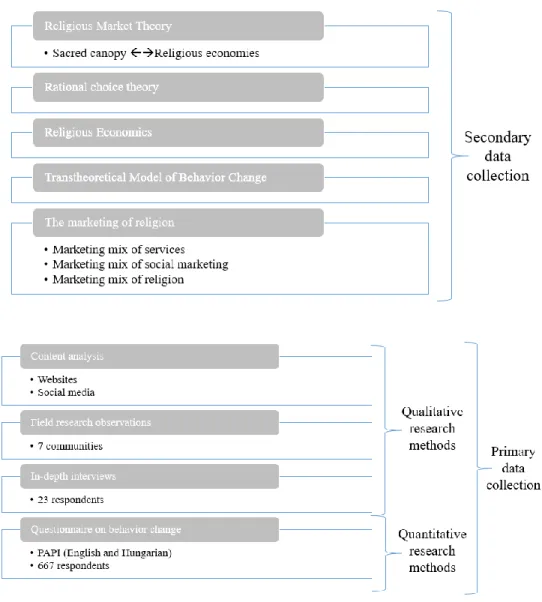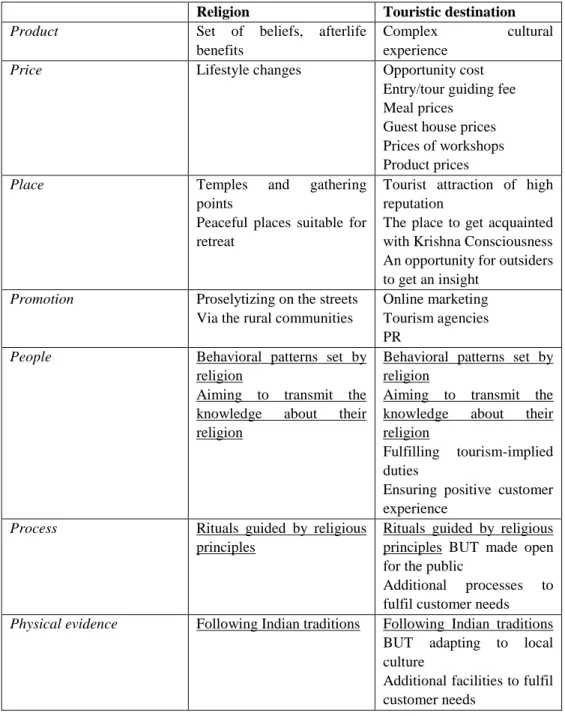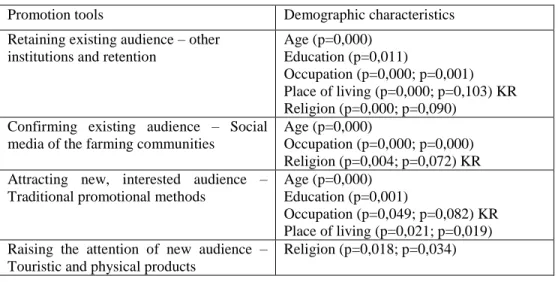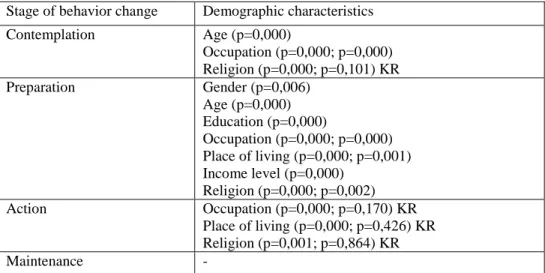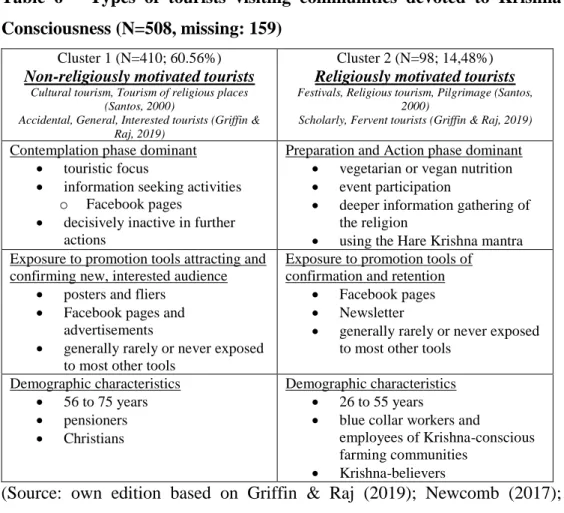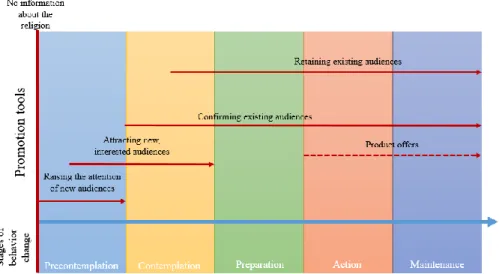Szent István University
–Kaposvár Campus
Faculty of Economic Sciences Institute of Marketing and Management
Head of Doctoral School:
PROF. DR. IMRE FERTŐ
Doctor of the Hungarian Academy of Sciences
Supervisor:
DR. HABIL. ORSOLYA SZIGETI
Associate Professor
STRATEGY SET BY FAITH - ANALYZING THE MARKETING CONCEPTS OF COMMUNITIES DEVOTED
TO KRISHNA CONSCIOUSNESS IN EUROPE
Author:
KRISZTINA BENCE-KISS
KAPOSVÁR
2020
DOI: 10.17166/KE2021.002
2
Table of contents
1. Introduction ... 3
2. Aims of the dissertation ... 4
3. Material and methodology ... 5
4. Research results and evaluation ... 8
4.1. The marketing model of Krishna-conscious communities in Europe 8 4.2. Tools promoting Krishna Consciousness in Europe ... 11
4.3. Behavior changes concerning Krishna Consciousness among the visitors of rural communities ... 14
4.4. The relationship between promotion tools and behavior changes ... 18
4.5. Types of tourists visiting communities devoted to Krishna Consciousness ... 20
5. Proposals and recommendations ... 22
6. Further research directions ... 26
7. New scientific results ... 27
8. Publications in the field of the dissertation ... 28
3
1. Introduction
Krishna consciousness was one of those new religious movements, which conquered the Western world around the 1960’s. Originating from India, the religious movement had reached the United States of America during the era of the Vietnamese War, spreading all over Europe as well during and after the Communist Era. After the fall of Communism in Eastern-Europe, and the consolidation of the post-World War II. situation, when practicing religions had become more free and new religious movements could also gain more place in the life of most of the European countries, Krishna consciousness was one of the first ones to spread; and soon communities started to form all over the continent (Harvey, 2000; Isvara, 2002; Kamarás, 1998; Klostermaier, 2000; Rochford, 2007).
Also, Krishna consciousness was – and still is – one of the best known religions of their promotional activities, which were initiated by people stopping pedestrians on the streets, telling them all about the teachings of their Lord Krishna. Nowadays ISKCON (International Society for Krishna Consciousness) has numerous churches, villages and visitors’ centers all over the world, hosting a large number of festivals, and engaging themselves in charitable activities, while communicating actively online and using the social media. Being are able to raise the attention of more and more people in countries far away from India, having barely no cultural similarities with this Eastern country and its traditions is an achievement suggesting a carefully set strategy of reaching and targeting people, which has received surprisingly small attention in the past decades. (Bence, 2014; Goswami, 2001; Harvey, 2000; Isvara, 2002; Kamarás, 1998; Klostermaier, 2000; Rochford, 2007;
Wuaku, 2012).
4
2. Aims of the dissertation
Since the amount of research existing on the marketing activities and strategies of the different religious communities is limited, the primary aim of this research is to start filling this gap by carrying out an exploratory analysis on the marketing activities of a new religious movement, Krishna Consciousness on the European continent.; with a goal of discovering and analyzing any existing strategies applied by marketers of the religion. To achieve this, four goals have been determined to be realized by the end of the research:
G1: Determining the marketing mix of the Krishna-conscious communities of Europe
G2: Examining the effects of Krishna-conscious farming communities in Europe appearing as touristic destinations on the behavior of people getting acquainted with them
G3: Analyzing the reach of promotion tools applied by Krishna- conscious communities of Europe among the visitors of the farming communities as touristic destinations
G4: Identifying and analyzing the behavior changes implied by the marketing activities of Krishna-conscious communities of Europe with the help of the Transtheoretical Model of Behavior Change
H1: The Transtheoretical Model of Behavior Change is applicable to analyze behavior changes concerning religion
H2: Promotion tools match the different stages of behavior change
H3: There is a relationship between the promotion tools applied and the behavior changes
5
3. Material and methodology
Figure 1 shows the progress of the research, introducing how one research method and its results have led to the other. Following the initial secondary research focusing on the evolution of religious marketing and the theories I also analyzed religious markets and the market decisions taken, then examined the theory on a living religious marketing example of Krishna Consciousness.
Figure 1 – Progress of the research
6
The primary data collection phase was made up of a combination of qualitative and quantitative research methods due to the exploratory manner of the research:
First of all online content analysis was carried out including the central sites of ISKCON websites and social media sites of Krishna-conscious communities of Europe in order to identify and localize the most important institutions of the religion and their marketing activities.
After identifying the most important drivers of the marketing activities – rural and farming communities – field research observations were carried out in seven communities of six countries (Hungary, Belgium United Kingdom, Czech Republic, Sweden and Germany) to analyze and compare their rural communities and understand their functions.
Twenty-three in-depth interviews were carried out in the seven communities involving devotees responsible for management, tourism and marketing to clarify and further evolve the most important findings of the content analyses and field researches.
With the help of the findings of the qualitative research phase, a questionnaire was formed to gather information concerning the exposure of the visitors of the rural communities to the different promotion tools applied and the level of the respondents’ involvement in the life and activities of the Krishna-conscious community. 667 valid responses have arrived in English and Hungarian in paper-and-pencil format, thanks to the support of the seven communities. The data were analyzed using SPSS 21.0 statistical software, applying a set of different methods to discover the relationship between the variables:
o Factor analysis (Varimax rotation with Kaiser Normalization., using Kaiser-Meyer-Olkin and Bartlett Tests to evaluate suitability for analysis and Cronbach’s Alpha test of reliability)
7
to find the factors describing exposure to the different promotion tools and behavior changes of the respondents.
o Welch ANOVA analysis of variance and Games-Howell post hoc tests to identify the differences in the means of the different groups considering further demographic characteristics.
o The relationship between the factors describing exposure to promotion tools and behavior changes were analyzed using Pearson correlation coefficients.
Following the quantitative research phase, when necessary, clarifying interviews were made with the respondents of the first interviews to discuss and clarify the information gathered.
8
4. Research results and evaluation
4.1.The marketing model of Krishna-conscious communities in Europe After carefully analyzing the methods devotees use to promote the religion, it became clear that some things have not changed in the past decades: the traditional way of promoting the religion was proselytizing to people on the streets and selling books, ever since the appearance of the religion in the Western World in the 1960’s (Kamarás, 1998; Wuaku, 2012). However, marketing and technology have developed a lot in the past fifty years, and people devoted to Krishna Consciousness consciously apply numerous new methods in order to fulfill the most important goal set by their spiritual leaders:
to spread the teachings of Krishna.
Nowadays we can distinguish four different types of institutions, which are responsible for the majority of the marketing activities related to Krishna Consciousness in Europe:
temples or centers
rural or farming communities
educational centers
restaurants (ISKCON, 2019, ISKCON Desire Tree, 2019).
Analyzing the promotional activities of Krishna Conscious communities of Europe a new model was discovered, in which the national communities initiate their activities of promoting the religion by creating a touristic product in the form of a farming or rural community. The other three types of institutions operated by the Krishna-conscious organizations – temples and centers, educational institutions and restaurants – focus their promotional activities on people, who are already acquainted and possibly engaged with the religion, while the promotion of farming and rural communities focuses on the newcomer audiences mainly.
9
Since religions are highly bound by religious economics – meaning that the activities they carry out are highly determined by the principles of the religion –, creating the touristic product is a good mean of overcoming the limitations and achieving more freedom in the marketing mix. Numerous researchers have suggested the use of the marketing mix of services (7P) in order to analyze religious marketing, however, when marketing a religion applying the marketing mix of services marketing, six out of the 7Ps are mainly determined by the religion, leaving the marketers freedom only in terms of promotion. On the other hand, by creating the touristic product, the religion will only influence, but not so strongly restrict the marketing mix elements.
Table 1 introduces the effects the shift of the product from religion to tourism implies in each element of the marketing mix: the factors underlined remain influenced by the religion, while in all the other elements the freedom became much higher.
10
Table 1 – The changes in the marketing mix by shifting the product from religion to touristic destination (Source: own edition)
Religion Touristic destination
Product Set of beliefs, afterlife benefits
Complex cultural
experience
Price Lifestyle changes Opportunity cost
Entry/tour guiding fee Meal prices
Guest house prices Prices of workshops Product prices
Place Temples and gathering
points
Peaceful places suitable for retreat
Tourist attraction of high reputation
The place to get acquainted with Krishna Consciousness An opportunity for outsiders to get an insight
Promotion Proselytizing on the streets Via the rural communities
Online marketing Tourism agencies PR
People Behavioral patterns set by religion
Aiming to transmit the knowledge about their religion
Behavioral patterns set by religion
Aiming to transmit the knowledge about their religion
Fulfilling tourism-implied duties
Ensuring positive customer experience
Process Rituals guided by religious principles
Rituals guided by religious principles BUT made open for the public
Additional processes to fulfil customer needs Physical evidence Following Indian traditions Following Indian traditions
BUT adapting to local culture
Additional facilities to fulfil customer needs
This model may be found in all the six countries participating in the research;
and in three of them the model is already working successfully, while four
11
smaller communities examined regard the three successful larger ones as role models for their progress. The farming communities of Hungary, Belgium and the United Kingdom offer visitors a complex touristic product, which serves the dual aim of providing a rich cultural experience to the visitors and transmitting knowledge about the religion.
4.2.Tools promoting Krishna Consciousness in Europe
The management of the farming communities – both the larger and the smaller ones – apply a wide range of promotion tools in order to attract visitors to their touristic destinations, where they gain the opportunity to educate the public about Krishna Consciousness in the forms of visitor experiences. The second phase of the research focused on these tools and the exposure of the visitors to them.
In terms of first encounters with the religion the most important means of promotion were the personal contact points, which included proselytizing activities of devotees – but also the word-of-mouth, which is a tool that cannot be controlled by the religious communities directly. However, the positive effects of the word-of-mouth may be efficiently boosted by increasing the number of visitors in the rural communities and ensuring their positive experiences.
Social media, though not so outstanding in terms of first encounters, turned out to be an important promotion tool in the longer run; Facebook pages were marked as a repeated source of information concerning Krishna Consciousness by the most respondents.
Concerning further, continuous communication with the potential followers, the promotion tools applied by Krishna-conscious communities can be divided into four factors based on their main target groups:
Retaining existing audience – other institutions and retention
12
Confirming existing audience – Social media of the farming communities
Attracting new, interested audience – Traditional promotional methods
Raising the attention of new audience – Touristic and physical products
The quantitative research has shown that at the moment most of the visitors of the rural communities participating in the research are exposed to the tools attracting new, interested audiences most frequently, which include fliers, posters and devotees proselytizing on the streets. Concerning frequency of exposure the second highest ranked group of promotion tools were the means of confirming existing audience, including the social media tools applied by the rural communities. Even fewer are exposed to those tools dedicated for retaining existing audience, which implies that more emphasis should be put on engaging those, who have already got acquainted and probably interested in the religion. On the other hand, since at this level the product shifts back from touristic to religious, we need to admit that it is a natural phenomenon that the number of positive replies decreases. Also, the level of involvement in the religion each promotion tool requires from the target group is increasing;
the observed price of remaining involved is higher, which again could be a reason for the lower number of positive replies. Since it is not the touristic product, which is in the focus anymore, the other institutions ran by the religious community gain higher importance in retention too, offering catering opportunities and education to those, who have started to get engaged in the Krishna-conscious lifestyle.
The level of exposure to the promotion tools aiming to raise the attention of new audiences was also low, however, being exposed to these tools does not necessarily mean that they visit the farming communities as well; which
13
explains the seemingly low level of success of these means of promotion – many of those receiving information via these channels may not have decided to visit; yet their attention could have already been raised, but these people are out of reach of the current research.
As Table 2 shows, there were significant differences in the exposure to the different sets of promotional activities concerning numerous demographic characteristics. The analyses have shown that the respondents between 26 and 55 years are the groups most exposed to the first three factors (retention, confirmation and attracting new audiences), while the exposure of those 56 years and older is generally low. In terms of retention and attracting new audiences there were differences concerning education as well: those with university degrees were the most often exposed to these information sources.
In line with the age groups, concerning occupation, pensioners were those, who met the tools of the first three factors the least often, while – consonant with the data gained from education – white-collar workers were the cluster of highest exposure. Tools attracting new audiences have reached more respondents in the capital, than in regional centers and other towns or cities.
The tests were carried out both including and excluding the respondents already engaged in Krishna Consciousness, therefore the KR denomination in Table 2 represents those cases, where significant differences occurred only before excluding respondents devoted to Krishna Consciousness. The results have shown that devotees of Krishna Consciousness were significantly more exposed to tools of retention and confirmation but also partially to raising the attention of new audiences, which can mainly be attributed to the product sales of farming communities. An interesting phenomenon shown by the research was that while respondents belonging to Christianity were less exposed to the retention tools, they were more exposed to the means of raising attention than the mean of the whole sample.
14
Table 2 – The relationship between the exposure to promotion tools and demographic characteristics
Promotion tools Demographic characteristics
Retaining existing audience – other institutions and retention
Age (p=0,000) Education (p=0,011)
Occupation (p=0,000; p=0,001) Place of living (p=0,000; p=0,103) KR Religion (p=0,000; p=0,090)
Confirming existing audience – Social media of the farming communities
Age (p=0,000)
Occupation (p=0,000; p=0,000) Religion (p=0,004; p=0,072) KR Attracting new, interested audience –
Traditional promotional methods
Age (p=0,000) Education (p=0,001)
Occupation (p=0,049; p=0,082) KR Place of living (p=0,021; p=0,019) Raising the attention of new audience –
Touristic and physical products
Religion (p=0,018; p=0,034)
4.3.Behavior changes concerning Krishna Consciousness among the visitors of rural communities
During the analysis of the behaviors of the respondents regarding Krishna Consciousness H1 hypothesis was confirmed; the Transtheoretical Model of Behavior Change may be applied not only to measure the changes in individuals’ behavior concerning addictions and health behaviors, but also engagement to a religious community. The activities taken by the respondents could be categorized into four groups based on the level of active participation in the life of the religion, which could be matched to four out of the five stages of the Transtheoretical Model of Behavior Change. The first stage, Precontemplation was missing, since the data were collected among the visitors of seven Krishna-conscious communities in Europe, therefore have already expressed their interests towards the religion, while Precontemplation is the phase where the subjects do not have any interests and possibly not even knowledge about the behavior changes, which could be made. This is why it is important to target these audiences with the help of the promotion tools raising
15
attention and attracting people, who are interested to visit the rural communities. Precontemplation phase however could also be examined via discovering, which were the first contact points of the respondents with the religion. Here we can see that tools of attracting new, interested audiences were marked by the most respondents as the first channels of getting acquainted with the religions, which accounts of their success. However, promotion tools dedicated to raise the attention of those not having knowledge about the religion were marked being exposed to frequently by a small group of respondents only, which shows that there is space for improvement at this stage.
Contemplation however has already appeared among the respondents, including activities primarily focusing on the touristic product of farming communities, such as information seeking, visiting and remaining informed about the community. Since the initial relationship has already been established, in this phase all the elements of the marketing mix of the touristic product gain importance to be able to provide a complex cultural experience, which may be crucial in terms of future contact with the religion. Here religions may utilize the positive effects of shifting the product to tourism, therefore being able to work with a much wider set of toolbar. Following the visit, the most important goal of marketers in the Contemplation phase is to confirm the audiences and keep them in connection with the religious community. At this stage they are going to return to focusing on promotion tools only, since other elements of the marketing mix are heavily determined by religious economics.
Tools of retention – especially different forms of education are already starting to be important at this stage, but their importance further increases as the people step into the phase of Preparation, where they already take actions and make modifications in their lifestyle, therefore start to get actively involved in the religion. At the level of Preparation it is not the touristic product, what is
16
in the focus anymore, therefore the perceived price of involvement – which was decreased by the touristic product – is starting to increase again, requiring more sacrifices from the individuals.
As Table 3 shows, at these stages – Contemplation and Preparation – there are numerous demographic characteristics, which influence the actions the individuals are going to take. Respondents between 26 and 55 years are the most active in terms of behavior change; especially blue- and white-collar workers. Visitors of 56 years or older, and pensioners in general were less active in changing their behavior, they usually remain only tourists, but do not become more involved. Those with a higher level of education – university degrees – are more likely to reach also the level of Preparation and take actions to become parts of the religious community; starting over primarily with changes in nutritional patterns and engaging in a vegetarian or vegan lifestyle.
Table 3 – The relationship between the stages of behavior change and demographic characteristics
Stage of behavior change Demographic characteristics
Contemplation Age (p=0,000)
Occupation (p=0,000; p=0,000) Religion (p=0,000; p=0,101) KR
Preparation Gender (p=0,006)
Age (p=0,000) Education (p=0,000)
Occupation (p=0,000; p=0,000) Place of living (p=0,000; p=0,001) Income level (p=0,000)
Religion (p=0,000; p=0,002)
Action Occupation (p=0,000; p=0,170) KR
Place of living (p=0,000; p=0,426) KR Religion (p=0,001; p=0,864) KR
Maintenance -
It is going to be however a demographically heterogeneous group, which may achieve a level of Action, where visible actions are taken, showing that the individuals are parts of the Krishna-conscious community, such as wearing
17
traditional Indian dresses and attending temples regularly. At this stage the perceived price of the religion becomes the focal point again and by reaching this level individuals have accepted most – but in many cases not all – of the prices required by the religion to remain an active member. The only common characteristic of the respondents at this stage was their religious belonging; and the importance of retention tools started decreasing; leaving it for the power of the community and one’s own determination to keep people involved.
However, dropout rates are higher at this level, even after several years, which means that several members never really achieve the stage of Maintenance.
Dropout is still possible at this level, and certain retention tools exist to prevent this, but their influences are not so strong. On the other hand informal means of retention exist, but they are less measurable and less visibly communicated to people involved in the religion, which may decrease their efficiency in retention.
These research results have shown H2 to be confirmed as well; the different sets of promotion tools may be linked to the stages of behavior change, as Table 4 shows.
Table 4 – The relationship between promotion tools and the stages of behavior change (Source: own edition)
Stage of behavior change Promotion tools
Precontemplation Raising the attention of new audience – Touristic and physical products
Attracting new, interested audience – Traditional promotional methods
Contemplation Confirming existing audience – Social media of the farming communities
Preparation Confirming existing audience – Social media of the farming communities
Retaining existing audience – other institutions and retention Action Retaining existing audience – other institutions and retention Maintenance Retaining existing audience – other institutions and retention
18
4.4.The relationship between promotion tools and behavior changes
After analyzing the groups of promotion tools applied and the behavior changes taken by the respondents, relationship between the two sets of factors could be assumed, which lead to the formulation of the hypothesis:
H3: There is a relationship between the promotion tools applied and the behavior changes
As seen in Table 5, the hypothesis was confirmed in four cases, strong correlation was found between the promotion tools confirming existing audiences and the stage of Contemplation and moderate correlations concerning the tools of retaining existing audiences and Preparation, Action and Maintenance. The hypothesis was rejected regarding the correlation between confirming existing audiences and the Preparation phase, where no significant relationship was shown in this case. However, new relationships were detected too; means of retention may already take their effect in the stage of Contemplation and – interestingly – certain elements of the methods raising the attention of new audiences gain importance on the level of Action and Maintenance too, which may be attributed to vegetarian and vegan products distributed by Krishna-conscious communities. In the table confirmed relationships are marked by a tick, while X represent those occasions, where no significant relationships were observed. The relationships marked with exclamation mark are those cases, where relationship was not assumed, yet significant correlation was discovered between the variables.
19
Table 5 – The relationship between the stages of behavior change and exposure to the different promotion tools
Stage of behavior change
Promotion tools Pearson correlation coefficient
Significance level
Confirmed
? Precontemplation Raising the attention
of new audience – Touristic and physical products
No data available X
Attracting new, interested audience – Traditional promotional methods
No data available X
Contemplation Confirming existing audience – Social media of the farming
communities
0,764 0,000
Retaining existing audience – other institutions and retention
0,233 0,000 !
Preparation Confirming existing audience – Social media of the farming
communities
0,043 0,344 X
Retaining existing audience – other institutions and retention
0,488 0,000
Action Raising the
attention of new audience – Touristic and physical products
0,204 0,000 !
Retaining existing audience – other institutions and retention
0,281 0,000
Maintenance Raising the attention of new audience – Touristic and physical products
0,347 0,000 !
Retaining existing audience – other
0,373 0,000
20 institutions and retention
4.5.Types of tourists visiting communities devoted to Krishna Consciousness
As seen in Table 6, the analyses have shown that most of the tourists arriving to communities devoted to Krishna Consciousness are non-religiously motivated, generally in the Contemplation phase; and only a small proportion of the visitors arrive for religious reasons or are in the phases of Preparation and Action; which confirms the need for rural communities as a first stage of marketing the religion, providing information and aiming to direct visitors towards further stages of behavior change.
21
Table 6 – Types of tourists visiting communities devoted to Krishna Consciousness (N=508, missing: 159)
Cluster 1 (N=410; 60.56%) Non-religiously motivated tourists
Cultural tourism, Tourism of religious places (Santos, 2000)
Accidental, General, Interested tourists (Griffin &
Raj, 2019)
Cluster 2 (N=98; 14,48%) Religiously motivated tourists
Festivals, Religious tourism, Pilgrimage (Santos, 2000)
Scholarly, Fervent tourists (Griffin & Raj, 2019) Contemplation phase dominant
touristic focus
information seeking activities o Facebook pages
decisively inactive in further actions
Preparation and Action phase dominant
vegetarian or vegan nutrition
event participation
deeper information gathering of the religion
using the Hare Krishna mantra Exposure to promotion tools attracting and
confirming new, interested audience
posters and fliers
Facebook pages and advertisements
generally rarely or never exposed to most other tools
Exposure to promotion tools of confirmation and retention
Facebook pages
Newsletter
generally rarely or never exposed to most other tools
Demographic characteristics
56 to 75 years
pensioners
Christians
Demographic characteristics
26 to 55 years
blue collar workers and
employees of Krishna-conscious farming communities
Krishna-believers
(Source: own edition based on Griffin & Raj (2019); Newcomb (2017);
Prochaska & Velicer (1997); Santos (2000); University of Maryland (2020))
22
5. Proposals and recommendations
R1: Evaluating the research results we could see that the Transtheoretical Model of Behavior Change can provide guidelines for scheduling and organizing the marketing activities to reach higher efficiency – but to achieve this it is crucial to know the current and potential audiences and to be able to identify which stage of change they are currently in. This may be realized with the help of statistics Krishna-conscious communities possess on the behaviors of their active members, but also by observations and researches via questionnaires among the members. In countries, where farming communities exist, their visitors are also an important pool for carrying out such researches.
There are also possibilities for involving the wider public, cooperating with companies specialized in market research.
R2: After identifying the stages of behavior change the present and potential audiences are, setting up a marketing strategy based on the research results, by focusing on the most important tools taking effect at each stage. The timeline of Figure 2 shows, which sets of promotion tools need to be considered in each stage.
23
Figure 2 – Recommended timeline of scheduling the promotional activities based on the Transtheoretical Model of Behavior Change (Source: own edition)
R2.1.Precontemplation
As the timeline shows, in the Precontemplation stage tools of raising the attention and attracting new audiences take their effect. The tools of attracting new, interested audiences performed highest in establishing initial contacts, however, those of raising attention did not seem to have reached their goals.
At this stage there is a need for development, which can be reached by extending the toolbar, also including new media (e.g. TripAdvisor; Facebook and Instagram advertising), which was mentioned more frequently as an initial contact, that the current elements of raising the attention.
R2.2. Contemplation
The touristic product is a crucial point of the Contemplation stage, which should be kept and maintained by those countries, where they already exist and attract huge audiences; and improved in those, where the farming communities already exist, but lack touristic significance at the moment to be able to benefit
24
more of utilizing all the elements of the marketing mix of services. It is recommended to countries without rural communities to invest in establishing these kind of institutions, as their benefits are clearly visible.
Also in the countries with successful tourist attractions, improvements may be made in terms of the promotion tools confirming existing audiences, since there are groups, which are less frequently exposed to the existing tools and less engaged to get further involved:
a) age groups younger than 26 years could be reached more efficiently by putting more emphasis on social media tools other than Facebook (Instagram, YouTube) and introducing new social media platforms, also used by these generations (e.g. TikTok) in the portfolio
b) age groups of 56 years and older may be reached in the form of online and offline articles providing information and news about the communities continuously
R2.3. Preparation
Currently Preparation phase lacks confirmation, even though the transtheoretical model of behavior change emphasizes its importance at this stage; and also the influence and range of the existing retention tools could be further improved:
a) the expansion of current and future tools of confirmation, such as the messages of social media tools could be extended to bear more relevance to people in the stage of Preparation, therefore decrease the rate of dropout
b) since the focal point of this stage is nutrition, product sales and the communication of restaurants fostering the changes in nutrition
25
patterns should focus their communication more on people in the Preparation phase to make lifestyle changes easier
R2.4. Action and Maintenance
Similarly to the Preparation phase, those at the level of Action and Maintenance should receive more confirmation and be exposed to more means of retention too. Besides maintaining the actions of confirmation and activities supporting nutritional changes, a greater emphasis should be put on education by offering more opportunities in more visible ways, employing the platforms of social media as well.
26
6. Further research directions
D1: Since the research was carried out with the help of seven farming communities of six countries, whereas there are a total number of eighteen rural communities in fourteen countries, therefore the first step after the completion should be to establish relationship with the Krishna-conscious communities of all the countries with farming communities to increase the volume of the research.
D2: After the completion of the researches on the European continent the same research structure may be extended to countries outside Europe, where Krishna-consciousness is registered as a new religious movement, which includes North- and South America, Australia and Africa as well, but also parts of the Asian continent.
D3: The research was already expanded further on to evaluate not only the marketing activities, but also their effects on the image and the reputation of the religious community.
D4: The complex analysis may further be extended to other religions, not only new religious movements, but also other religions of the world.
27
7. New scientific results
This chapter summarizes the new scientific results discovered during the research:
1. It was discovered that there has been a shift of focus in terms of product from religion to touristic destination. When marketing religions, most elements of the marketing mix are determined by the religion, whereas the marketing mix may be freely utilized in the marketing of the touristic destination.
2. Based on this it a two-phase marketing model was identified: in the first phase the touristic product is the subject of the marketing activities, but after the first visit had happened, the focus shifts back to religion and further institutions are employed too in order to gain more followers.
3. The researches have shown that the Transtheoretical Model of Behavior Change may be applied to analyze the behavior of people during the process of getting acquainted and engaged with a religion.
4. It could also be concluded that promotion tools of a religious community may be aligned to the Transtheoretical Model of Behavior Change, distinguishing the promotion tools, which may be applied the most efficiently in each phase.
5. It was proved that there is a significant relationship between the exposure to the different promotion tools and the stage of behavior change the respondents are in.
6. As a conclusion of the previous findings promotion timeline was created, which indicates the ideal sets of promotion tools to be applied targeting the audiences in the different stages of behavior change.
28
8. Publications in the field of the dissertation
Scientific papers in English
Bence-Kiss, K. & Szigeti, O. 2020. Evaluating the two-step marketing model of Krishna Consciousness in Hungary. Balkans Journal of Emerging Trends in Social Sciences 3(1)
Bence-Kiss, K. & Szigeti, O. 2020. The way farming communities became the focal point of marketing Krishna Consciousness in Europe. Apstract Bence-Kiss, K. & Szigeti, O. 2020. Exploratory analysis of marketing the Krishna-conscious communities in Europe. Detourope
Bence-Kiss, K. & Szigeti, O. 2019. Exploring the Marketing Strategies of Krishna Consciousness in Europe. International Journal of Multidisciplinarity in Business and Science (1849-0581): 5(8) 21-31.
31039619
Full papers in English
Bence, K. 2017. Commodities Produced by Religious Communities on the Food Market: Competitive Advantage or Ruining Reputation? Journal of Emerging Trends in Marketing and Management 1(1) 95-104.3296138 Full papers in Hungarian
Bence, K. 2017. Turisztikai motivációk és vonzerők a Krisna Völgyi Búcsú vonatkozásában. Turisztikai és Vidékfejlesztési Tanulmányok 2(2) 49-64.
3258429
Bence-Kiss, K. ? A Krisna-tudatú közösségek hatása az európai kistelepülések lakosságára, látogatottságára, Köztes-Európa (megjelenés folyamatban)
Full papers in proceedings in Hungarian
29
Bence, K. 2017. A Krisna völgy turisztikai jelentősége a Krisna völgyi búcsú vonatkozásában, A Kárpát-medence turizmusának és vidékfejlesztésének aktuális kérdései: Tanulmányok a turizmus és a vidékfejlesztés témaköréből.
160 p. Szekszárd: PTE, Kultúratudományi, Pedagógusképző és Vidékfejlesztési Kar,
3236275 szaktanulmány tanulmánykötetben
Bence-Kiss, K. 2019. A Krisna-tudatú közösségek marketingmodellje Európában, Ifjúsági Tudományos Fórum 23. May 2019. Keszthely
Befoglalója: 30689171 | CD , 31302425 Abstracts in proceedings in English
Bence-Kiss, K. 2019. The contribution of the Krishna Conscious community to sustainable consumption in Hungary. International Conference on Sustainable Economy and Agriculture 14th November 2019 p. 92
31125705.
Bence-Kiss, K. & Szigeti, O. 2019. Evaluating the two-step marketing model of Krishna Consciousness in Hungary at 3rd International Scientific Conference on IT, Tourism, Economics, Management and Agriculture, Bratislava, Slovakia; 27th October 2019
Bence-Kiss, K. 2018. Marketing Models of Krishna consciousness in Europe;
7th International M-Sphere Conference 12-14, December, 2018. Zagreb, University of Zagreb.31281190
Bence-Kiss, K. 2017. Commodities Produced by Religious Communities on the Food Market: Competitive Advantage or Ruining Reputation? Emerging Trends in Marketing and Management 28-30. September 2017. Bucharest, Bucharest University of Economic Studies3296138
30
Bence, K. 2017. When strategy is set by faith – analysis of the Krishna Valley products. 6th International Conference of Economic Sciences 4-5. May 2017.
Kaposvár, Kaposvár University, Faculty of Economic Science. 3236286 Abstracts in proceedings in Hungarian
Bence-Kiss, K. 2018. A Krisna-tudatú közösségek hatása az európai kistelepülések lakosságára, látogatottságára. XII. Régiók a Kárpát-medencén innen és túl konferencia 12. October 2018. Kaposvár University, Faculty of Economic Science
